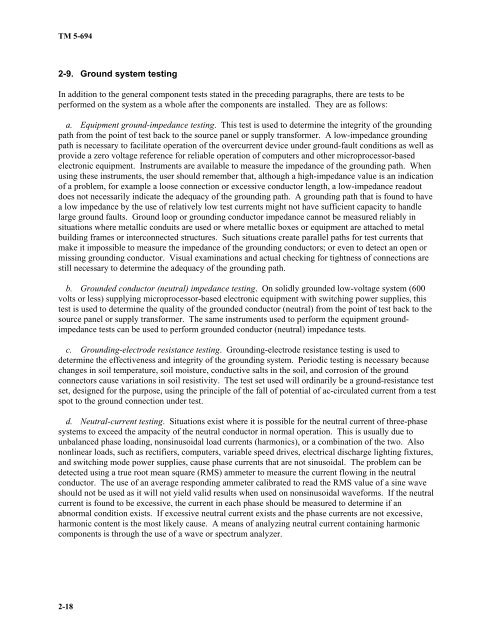Commissioning of Electrical Systems for Command, Control
Commissioning of Electrical Systems for Command, Control
Commissioning of Electrical Systems for Command, Control
You also want an ePaper? Increase the reach of your titles
YUMPU automatically turns print PDFs into web optimized ePapers that Google loves.
TM 5-694<br />
2-9. Ground system testing<br />
In addition to the general component tests stated in the preceding paragraphs, there are tests to be<br />
per<strong>for</strong>med on the system as a whole after the components are installed. They are as follows:<br />
a. Equipment ground-impedance testing. This test is used to determine the integrity <strong>of</strong> the grounding<br />
path from the point <strong>of</strong> test back to the source panel or supply trans<strong>for</strong>mer. A low-impedance grounding<br />
path is necessary to facilitate operation <strong>of</strong> the overcurrent device under ground-fault conditions as well as<br />
provide a zero voltage reference <strong>for</strong> reliable operation <strong>of</strong> computers and other microprocessor-based<br />
electronic equipment. Instruments are available to measure the impedance <strong>of</strong> the grounding path. When<br />
using these instruments, the user should remember that, although a high-impedance value is an indication<br />
<strong>of</strong> a problem, <strong>for</strong> example a loose connection or excessive conductor length, a low-impedance readout<br />
does not necessarily indicate the adequacy <strong>of</strong> the grounding path. A grounding path that is found to have<br />
a low impedance by the use <strong>of</strong> relatively low test currents might not have sufficient capacity to handle<br />
large ground faults. Ground loop or grounding conductor impedance cannot be measured reliably in<br />
situations where metallic conduits are used or where metallic boxes or equipment are attached to metal<br />
building frames or interconnected structures. Such situations create parallel paths <strong>for</strong> test currents that<br />
make it impossible to measure the impedance <strong>of</strong> the grounding conductors; or even to detect an open or<br />
missing grounding conductor. Visual examinations and actual checking <strong>for</strong> tightness <strong>of</strong> connections are<br />
still necessary to determine the adequacy <strong>of</strong> the grounding path.<br />
b. Grounded conductor (neutral) impedance testing. On solidly grounded low-voltage system (600<br />
volts or less) supplying microprocessor-based electronic equipment with switching power supplies, this<br />
test is used to determine the quality <strong>of</strong> the grounded conductor (neutral) from the point <strong>of</strong> test back to the<br />
source panel or supply trans<strong>for</strong>mer. The same instruments used to per<strong>for</strong>m the equipment groundimpedance<br />
tests can be used to per<strong>for</strong>m grounded conductor (neutral) impedance tests.<br />
c. Grounding-electrode resistance testing. Grounding-electrode resistance testing is used to<br />
determine the effectiveness and integrity <strong>of</strong> the grounding system. Periodic testing is necessary because<br />
changes in soil temperature, soil moisture, conductive salts in the soil, and corrosion <strong>of</strong> the ground<br />
connectors cause variations in soil resistivity. The test set used will ordinarily be a ground-resistance test<br />
set, designed <strong>for</strong> the purpose, using the principle <strong>of</strong> the fall <strong>of</strong> potential <strong>of</strong> ac-circulated current from a test<br />
spot to the ground connection under test.<br />
d. Neutral-current testing. Situations exist where it is possible <strong>for</strong> the neutral current <strong>of</strong> three-phase<br />
systems to exceed the ampacity <strong>of</strong> the neutral conductor in normal operation. This is usually due to<br />
unbalanced phase loading, nonsinusoidal load currents (harmonics), or a combination <strong>of</strong> the two. Also<br />
nonlinear loads, such as rectifiers, computers, variable speed drives, electrical discharge lighting fixtures,<br />
and switching mode power supplies, cause phase currents that are not sinusoidal. The problem can be<br />
detected using a true root mean square (RMS) ammeter to measure the current flowing in the neutral<br />
conductor. The use <strong>of</strong> an average responding ammeter calibrated to read the RMS value <strong>of</strong> a sine wave<br />
should not be used as it will not yield valid results when used on nonsinusoidal wave<strong>for</strong>ms. If the neutral<br />
current is found to be excessive, the current in each phase should be measured to determine if an<br />
abnormal condition exists. If excessive neutral current exists and the phase currents are not excessive,<br />
harmonic content is the most likely cause. A means <strong>of</strong> analyzing neutral current containing harmonic<br />
components is through the use <strong>of</strong> a wave or spectrum analyzer.<br />
2-18
















